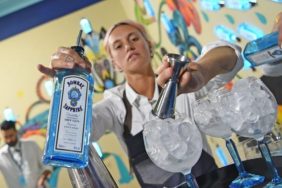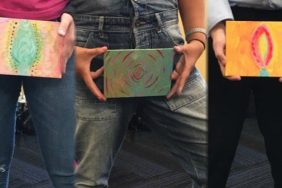Images: HSV Hall of Fame
Half the fun of paint shopping is in reading the names given to the paint designed to put you in the mood to paint your home. Who isn’t swayed just a little by the thought of Sweet Celadon, Balboa Mist, or Collingwood? The strangely evocative names add a mood to the most casual of beige or subtle of cream, getting you excited for the thought of a bathroom decked out in Dolphin Fin and Gentleman’s Grey: so sophisticated.
Also: The Late, Great Glenn O’Brien’s Last Book “Like Art” Takes on Advertising
Research scientist Janelle Shane was intrigued by the fact that there are people who make their living coming up with these names—and they’re out here on Reddit doing AMAs. Shane was intrigued by the interplay between color and name, recognizing that, “Given that the human eye can see millions of distinct colors, sooner or later we’re going to run out of good name.”

She wonders, “Can AI help?” and sets out to investigate, giving a neural network a list of about 7,700 Sherwin-Williiams paint colors along with their RGB (red, green, blue) color values. Shane recognizes early in that the computer does not inherently distinguish the colors from their names. Black Hand is decadently mint while Gray Pubic is a bold turquoise.
Shane soon realizes the neural network has its own preferences for browns, beiges, and greys, consistently generating drab upon drab tons that would depress you all day. It also has a taste for unusual names: Dorkwood, Snowbonk, and Stoner Blue are the better of the bunch, but you can always go for Turdly, Ghastly Pink, or Light of Blast if you’re in a crunch.

Shane is not deterred, and keeps on, determined to train the neural network to do better. She added a variable of temperature and turned it down, creating results that were more appealing in both shade and name. Well, perhaps not Queen Slime. Back to the drawing board.
The public got engaged and sent Shane ways to improve the algorithm, turning to HSV (hue, saturation, and value) to tweak the equations. Now we’re getting somewhere, somewhat. The colors become far more appealing, but the names…not so much. Mimily, Hocytel, Lifzan—what does it all mean? Is it better to simply go with Toes Brown?
It seems AI is only as intelligent as you tell it to be, so more input was needed until lovely shades like Otter Rose, Bright Beach, and Frosty Stone began to appear. “The results were… surprisingly good,” Shane writes. “Pretty much every name was a plausible match to its color (even if it wasn’t a plausible color you’d find in the paint store). The answer seems to be, as it often is for neural networks: more data.”
She creates a Hall of Fame that includes Shy Bather, Dinkwart, Kold of Tale, and Dorky Brown, which may appeal to the more subversive personalities who are tired of being sold on classic Sherwin Williams colors like Paradiso, Salty Dog, and Robin’s Nest.
All images: Screenshots taken by Janelle Shane.
Miss Rosen is a journalist covering art, photography, culture, and books. Her byline has appeared in L’Uomo Vogue, Vogue Online, Whitewall, The Undefeated, Dazed Digital, Jocks and Nerds, and L’Oeil de la Photographie. Follow her on Twitter @Miss_Rosen.
Janelle Shane
-
New Paint Colors Invented by Computer Algorithm

Hall of Fame: Big RGB Dataset
-
New Paint Colors Invented by Computer Algorithm

Hall of Fame: LAB
-
New Paint Colors Invented by Computer Algorithm

Hall of Fame: RGB
-
New Paint Colors Invented by Computer Algorithm

Hall of Fame: HSV
-
New Paint Colors Invented by Computer Algorithm

-
New Paint Colors Invented by Computer Algorithm

-
New Paint Colors Invented by Computer Algorithm

-
New Paint Colors Invented by Computer Algorithm

-
New Paint Colors Invented by Computer Algorithm

-
New Paint Colors Invented by Computer Algorithm

-
New Paint Colors Invented by Computer Algorithm

-
New Paint Colors Invented by Computer Algorithm







